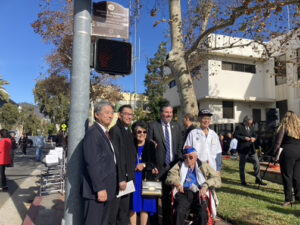
By Mikaela STONE
The story of Congressional Medal of Honor recipient Sadao S. Munemori remains not well known, even in his hometown of Glendale. As a young man, Sadao “Spuds” Munemori, nicknamed for his love of potatoes, joined the United States Army shortly before the U.S. entered into World War II. Following the bombing of Pearl Harbor, paranoia surrounding Japanese Americans ran rampant, resulting in the Army segregating Japanese American nisei, or second generation, soldiers into a separate regiment. Acting on that same paranoia, President Franklin Roosevelt ordered Japanese Americans to be incarcerated in concentration camps for the duration of the war – including Munemori’s family. In spite of this injustice, Munemori continued to serve the army in the 442nd Regimental Combat Team until he made the ultimate sacrifice.
A year after the beginning of his combat tour, upon taking the mantle of leadership from his injured squad leader, Munemori took out two enemy machine guns before an enemy grenade bounced off his helmet and into the foxhole where two of his men stood waiting. Munemori threw himself on the grenade to protect his comrades, saving both of their lives. He was only 23 years old. His efforts went a long way toward breaking the Gothic line in Italy and victory for the Allied Powers. He was posthumously awarded the medal of honor – the first Japanese American to receive the honor. The 442nd Regimental Combat Team would go on to become the most decorated regiment of its size – all while its soldiers’ families awaited their return from behind barbed wire.
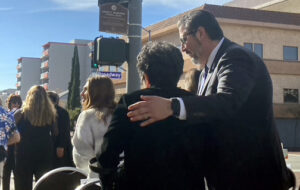
On Saturday, the City of Glendale hosted an event for the designation of the intersection of Isabel Street and Broadway as Sadao S. Munemori Memorial Square. The dedication on Saturday of the Sadao S. Munemori Square to Munemori’s memory was done in the hopes that his bravery will be better known. The Square contains a listing carved in stone of the names of Glendale locals who died in combat, extending from WWI to the present day.
Dr. Mitchell T. Maki presided over Saturday’s ceremonies as a member of the nonprofit Go for Broke Education Center, which seeks to educate the populace about the 442nd Regimental Combat Team and heroes such as Munemori. The nonprofit seeks to uphold what it believes Munemori embodied: the “American promise that no one would be judged by their country of origin, the color of their skin, or the faith they keep.” Maki additionally acknowledged Yosh Nakumara and Ed Nakumara (who are not related), two members of the 442nd Regiment who are Glendale locals and were present at the dedication unveiling.
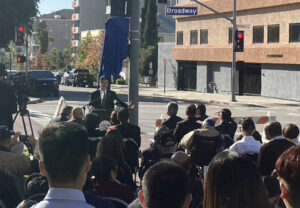
The memorial resulted from the combined efforts of many organizations, including Go For Broke, the Consulate General of Japan in Los Angeles, the Japanese American Museum and the unanimous vote of the Glendale City Council. Councilmembers have stood firm on the importance of teaching history and acknowledging both greatness in heroes, such as Munemori, and the weaknesses in America’s past, such as slights that America committed against its own citizens.
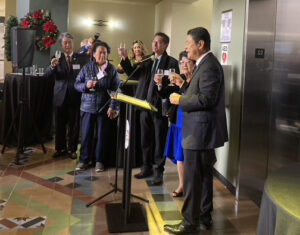
City Councilmember Ardy Kassakhian is counted among the lobbyists for widespread knowledge of Munemori. As a former history professor, he recalled a question asked by one of his students: “How do you love a country that doesn’t love you back?” Kassakhian believes the answer is to have faith in the idea of America as a place where equality reigns and to act in the interest of the greater good, which he cites Munemori’s actions as exemplifying. As James Nakakihara, the grand nephew of Munemori, reminded the crowd, the story is not yet over.
“What happened to Japanese Americans could happen to any ethnic group if we don’t learn from the mistakes of the past,” he said. He added it is his hope that the memorial will inspire kindness.
This hope is parallel with the ongoing mission of the Go For Broke National Education Center, which teaches the past in the hope of bolstering equality. In addition to educating the public through events such as the dedication of the Sadao S. Munemori Square, the nonprofit provides a youth program called The Torchbearers, which seeks to uphold the American promise of equality through the uplifting of young people. Multiple members of The Torchbearer’s program attended the ceremony, including Lindsey Sugimoto, who is continuing her family’s legacy of service – with her own twist: teaching history as means of cross-cultural understanding. For Torchbearer Charlie Yamamoto, the program helped him find a welcoming community to call his own. Yamamoto acknowledged the importance of remembering that stories such as Munemori’s and the 442nd Regimental Combat Team are not just war stories, but cultural stories.
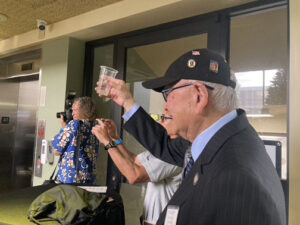
To many Americans, the oppression faced by those with Japanese roots as a result of racism and paranoia may seem far removed, but for valley locals the truth is very close at hand. The much-contested Verdugo Hills Golf Course property is the former site of Tuna Canyon Detention Station, which detained over 2,000 Americans without charge of wrongdoing. While the majority of the camp’s prisoners were Japanese Americans, there is also evidence of Italian and German detainees – even a group of Polish prisoners fleeing Stalin – being held there, as reported by the Cold War Radio Museum. Although the majority of these people were held there only briefly before American forces sent them to more permanent camps, such as Manzanar, the Tuna Canyon Detention Station operated from 1941 to 1943 as a “male only” way station. For the three years these permanent camps operated, whole families were separated as men were held under increased suspicion as possible spies. Families lost businesses, farms, homes and even pets as they were given short notice of their imprisonment and no definite answer as to how long they would be held. While recognition of the past does not bring back what was lost, it helps to safeguard the future.
